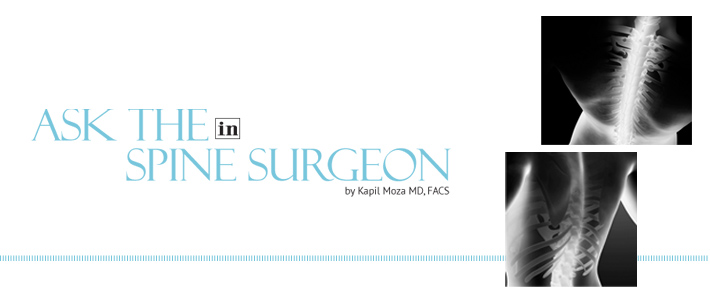HEALTH - PAIN FREE FOR LIFE
Ask the Spine Surgeon
June, 2015 - Issue #128
 |
Hi Dr. Moza. I was recently told that my herniated disc requires repair which means... I need surgery. I'm not looking forward to the recovery, the hospital stay, the cost or the time off work. I've been assured that my pain and mobility will not improve without this surgery, but I'd really like to know if there's a way to do it that cuts down on "all of the above."
Thank you for your letter. I'm sorry to hear that you're in pain but I'm glad to know that you're taking the necessary steps to improve your quality of life.
Your concerns, of course, are valid. No one wants to have surgery and the inconveniences, pain and cost that so often accompany it make it all the worse to bear.
I may have good news for you, though. Outpatient spine surgery is an option for many back and neck procedures and can cut down on what you refer to as "all of the above." In my practice, most of my spine surgeries can be "same day" release or with a 23-hour hospital stay. In fact, I've been a leader in outpatient spine surgery for the last four years.
Here's why.
In my practice, I specialize in minimally-invasive spine surgery. "Minimally-invasive" has become quite an overused term in the surgical field; just because someone says that their procedure is "minimally invasive" doesn't mean it's as least invasive as possible. The way I see it, "minimally invasive" isn't just using an endoscope to perform a surgery. It's also about making only the most necessary cuts, leaving as much tissue as possible uninterrupted, choosing access angles that penetrate the least amount of tendon and muscle and ensuring minimal scarring and infection.
My patients experience minimally-invasive spine surgery that utilizes an operating microscope, which allows me to see inside a patient's body. The microscope is inserted through small incisions, generally a half-inch wide, allowing me to determine exactly what needs to be corrected without the conventional spine-surgery complications. I commonly treat failed surgeries performed at large teaching institutions in Los Angeles, Beverly Hills. No trainees, like students, interns or residents, are ever involved in the surgeries I perform.
Once a procedure has been completed, the incisions are sealed with sutures and covered with medical tape. A primary benefit of minimally-invasive spine surgery is the healing process. After a few months, the surgical wounds are hardly noticeable, as compared to a traditional spine surgery with a large, noticeable scar. And, because there's less trauma to the tissue, pain and surgical-site care can be easily managed in the comfort of your home. That means you're in the hospital for less than a day - and have a lower bill that reflects your quicker release. Your post-op pain will be dramatically less than in a standard spine surgery and your recovery time could range from as short as a week to a few months, compared to the year some patients require to heal from more-invasive spine surgery.
Minimally-invasive spine surgery has been successfully utilized on patients suffering from degenerative discs, deformities like scoliosis, herniated discs and those requiring spinal fusion.
If you'd like to know if your case qualifies for minimally-invasive treatment, give my office a call so we can schedule a consultation.
Kapil Moza MD, FACS
Diplomate, American Board of Neurological Surgery
Dr. Moza's Santa Clarita office is conveniently located in Valencia. 805-497-3622
|
||||||||||||||||||||||||||||





